Hairless Cat Breeds
Hairless cat breeds are not actually a breed of cat, but more a category or type of cat.
The hairless condition is caused by a recessive gene that must be present in both parents. Hairless cats are not really completely hairless, they just have very short, fuzzy hair that lies very close to the skin, giving a hairless appearance.
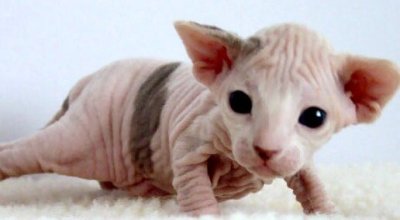
These types of cats will not make ideal pets for everybody, but if you are willing to give them the extra care and attention they deserve, a hairless cat will make the perfect pet. Cats such as the Sphynx are extremely loyal and affectionate cats and make ideal companions.
Even though these cats are hairless, it does not mean that you cannot be allergic to them as with the furry kinds. Cats that are hairless still shed skin cells and their saliva still contains the proteins that can cause an allergic reaction. What makes them a better solution for cat allergy sufferers is the fact that there is no fur that gets shed.
The History of Hairless Cat Breeds
In the 1830's there were written accounts of a hairless cat in Paraguay, but the first properly recorded hairless cat breed was the Mexican Hairless cat. In the early 1900's, a couple from New Mexico took two hairless cats from the local Pueblo Indians who claimed that the cats were survivors of an Aztec cat breed. The male cat died and the female cat was brought into Europe in 1903. Katharine L Simms wrote in They Walked Beside Me in 1954 about a peculiar hairless cat that lived in Mexico this was the Mexican Hairless.
Due to the lack of a proper breeding program, the Mexican Hairless was lost to the cat world. It still has not been confirmed whether a hairless cat that was found in 2006 was in fact a true Mexican Hairless.
Frances Simpson published a letter in 1903 in The Book of the Cat about two hairless cats that were owned by Mr EJ Shinick. Mr Shinick sadly did not breed with these cats and little is known about these two hairless cats.
In France in the 1930's hairless cats made their appearance, but these cats did survive. Photos of two hairless cats were published in a magazine in 1932 showing the cats at a cat show in Paris. Both the cats died in 1931 without having any offspring.
Mr Henry Sternberceh wrote a letter to The Journal of Heredity in 1936 about a hairless cat from North Carolina. A litter of kittens were born to an ordinary cat, but only one of the kittens was ordinary. The other three kittens were hairless and one even had no tail. Mr Sternberceh speculated that the appearance of the kittens were due to their mother being chased and frightened by a neighborhood dog whilst she was pregnant, but the Editor of the Journal replied that geneticists attributed the appearance to a recessive mutation and not to the mother.
The Sphynx originated from Canadian cats during the 1960's and 1970's. The Sphynx
is also known as the Canadian Hairless cat and either Sphinx or Sphynx are acceptable
spellings. In 1963 hairless kittens were discovered in Toronto and this trait was
due to a recessive gene.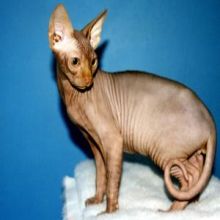 Breeding
was started with these kittens but was discontinued in the late 1970's. In 1973
the Journal of Heredity published a report on hairless cats and in 1978 the last
breeding pair was sent to Holland. This breeding pair did however not produce any
kittens.
Breeding
was started with these kittens but was discontinued in the late 1970's. In 1973
the Journal of Heredity published a report on hairless cats and in 1978 the last
breeding pair was sent to Holland. This breeding pair did however not produce any
kittens.
Female Sphynx cats were needed to produce a line of pure Sphynx hairless cats, but the genes of the last authenticated Canadian Hairless of the earlier strain, were lost. This is how it came about that the Sphynx cat breed was developed using the Devon Rex cat breed. The Devon Rex has been known to occur with sparse fur and the modern Sphynx has a light covering of fur.
The Journal of Heredity published a report in 1984 on 10 Birman kittens that were born hairless over a period stretching from 1978 to 1982. All these kittens died shortly after reaching 10 weeks of age. Death was attributed to an immune system disorder. Following a study in 1981, a lethal gene associated with hairlessness in cats was identified.
Hairless cat breeds continued to make their appearance from 1986 through to 1993 and in 1995 a hairless male kitten was incorporated into the Sphynx gene pool.
The first Elf cat was born in 2006. This cat was bred from a Sphynx cat and an American Curl cat. It has the Sphynx's hairlessness and the American Curl's ears. The Dwelf cat is another hairless cat breed, and is a result of a cross-breed between the Sphynx, the American Curl and the Munchkin.
For many years, the Canadian bred Sphynx was considered to be the main hairless cat breed. When the Don Sphynx made its appearance in 1987, this changed.
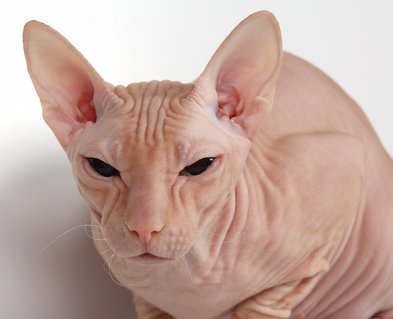 The Don Sphynx is also known as the Don Hairless, the Russian Hairless, the Don
Bald Cat or the Donskoy. The Donskoy originated in the Russian town Rostov-on-Don
when a kitten was rescued by Elena Kovalyova. This kitten became the foundation
female of the Donskoy breed.
The Don Sphynx is also known as the Don Hairless, the Russian Hairless, the Don
Bald Cat or the Donskoy. The Donskoy originated in the Russian town Rostov-on-Don
when a kitten was rescued by Elena Kovalyova. This kitten became the foundation
female of the Donskoy breed.
In 1993 Donskoy hairless cats were mated with Oriental and Siamese cats, creating an oriental hairless cat breed known as the Peterbald. A mating between an Oriental tortoiseshell female and a brown mackerel tabby Donskoy male resulted in the first Peterbald kittens being born in 1994. The Donskoy male was also mated with a Russian Blue and the kittens from this mating were incorporated into the Peterbald breeding program, so becoming foundation cats of this hairless cat breed.
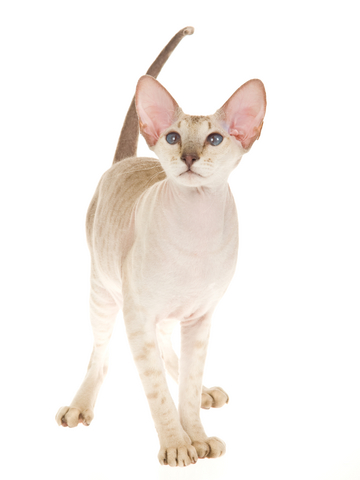 The Ukrainian Levkoy was created by mating a Don Sphynx and a Scottish Fold. The
result is a hairless cat with folded ears. The ears do not fold as tightly against
the skull as with the Scottish Fold, but folds closer to the tips. The Ukrainian
Levkoy's looks are less extreme than the looks of the Don Sphynx, with the face
being rounder and wider.
The Ukrainian Levkoy was created by mating a Don Sphynx and a Scottish Fold. The
result is a hairless cat with folded ears. The ears do not fold as tightly against
the skull as with the Scottish Fold, but folds closer to the tips. The Ukrainian
Levkoy's looks are less extreme than the looks of the Don Sphynx, with the face
being rounder and wider.
In 2002, a new hairless cat breed was being developed. The Hawaiian Hairless or Kohana cat is claimed to be completely hairless, lacking hair follicles. However, unconfirmed reports have been received about whether this hairless cat is the result of a mating between a Don Sphynx and a Canadian Sphynx.
Taking care of Hairless Cat Breeds
Hairless cat breeds are exposed to the sun, the wind and the cold. Therefore hairless cats should be indoor cats. You can purchase a sun block lotion from a veterinarian or a pet supply store. This lotion will have to be applied during the day the same as with human sun block.
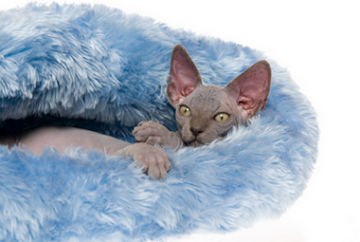 These
cats do not do well in cold, drafty places and should be protected against such
conditions. You can do this by providing a comfortable fur-lined basket or bed for
you hairless cat or by dressing him in a soft coat. (These are also available from
any pet supply store.)
These
cats do not do well in cold, drafty places and should be protected against such
conditions. You can do this by providing a comfortable fur-lined basket or bed for
you hairless cat or by dressing him in a soft coat. (These are also available from
any pet supply store.)
Just because there is a lack of fur does not mean there should be a lack of grooming. Hairless cats actually might require a bit more grooming than their furry counterparts. As these cats do not have hair that can absorb and distribute skin oils, the cat might feel oily to your touch. Breeders recommend baby shampoo or specialist shampoos available from veterinarians to bathe your cat with. After bathing, dry the cat with a soft baby towel and make sure that there are no drafts whilst you are bathing your cat.







